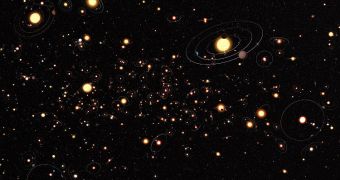A six-year study conducted on millions of stars in the Milky Way has revealed that the vast majority of stars have extrasolar planets in orbit. Previously, it was thought that star systems with planets were the exception, but the new work proves beyond a doubt that they are the norm.
This is a very important finding, which should theoretically guide the way humans conduct space exploration for generations to come. The study implies that the likeliness of us finding habitable worlds is very high, since the pool of potential candidates is impressively large.
The research team used a study technique called gravitational microlensing to conduct its study. The international collaboration included three experts from the European Southern Observatory (ESO).
Details of the work appear in the January 12 issue of the top scientific journal Nature. The study builds up on 16 years of astronomical research. During this time, experts confirmed more than 700 exoplanets, and the NASA Kepler Telescope proposed 2,300+ more.
But this type of research eventually led astronomers to a very basic question, related to how many planets are there in the galaxy, and how common these objects are. One of the facts that experts are certain of is that current search techniques are missing out on many worlds.
There are two primary ways of finding other worlds. One revolves around discovering tiny variations in a star's brightness, which may be indicative of a planet moving in front of it; this is the method Kepler uses. The other implies discovering a planet's gravitational influence on its parent star.
Both these techniques are biased towards discovering planets that are either large, or very close to their stars, respectively. This is why the research team used gravitational microlensing, an approach that allowed them to find planets over large mass and distance ranges.
“We have searched for evidence for exoplanets in six years of microlensing observations. Remarkably, these data show that planets are more common than stars in our galaxy,” Institut dʼAstrophysique de Paris (IAP) investigator Arnaud Cassan explains.
“We also found that lighter planets, such as super-Earths or cool Neptunes, must be more common than heavier ones,” adds the astronomer, who was also the lead author of the new study.
Data from the Optical Gravitational Lensing Experiment (OGLE) and Probing Lensing Anomalies NETwork (PLANET) surveys were critical for the microlensing study. Gravitational lensing is a technique that allows astronomers to use an object of high mass as a lens to see what's behind it.
“The PLANET collaboration was established to follow up promising microlensing events with a round-the-world network of telescopes located in the southern hemisphere, from Australia and South Africa to Chile. ESO telescopes contributed greatly to these surveys,” Jean-Philippe Beaulieu says.
The expert, who is also based at the IAP, is the leader of the PLANET collaboration. “Half of the data from the PLANET survey used in this study come from the Danish 1.54-meter telescope at ESO's La Silla Observatory,” an ESO press release explains.

 14 DAY TRIAL //
14 DAY TRIAL //